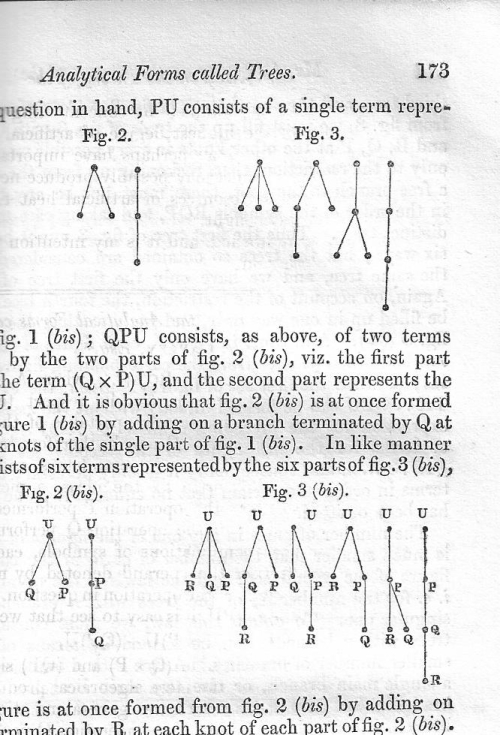The London, Edinburgh, and Dublin Philosophical Magazine and Journal of Science, fourth series, volume XIII, 1857. 21.5 x 13 cm, vii, 544pp, 2 engraved plates. Half leather and marbled boards; gilt stamped ownership oval on front cover of the Society of Writers to the Signet. The top panel of the leather backstrip is missing and there is scuffing to the red and black leather labels though they are still legible; also, the front board is detached. That said, the text is tight and the text is very crisp. GOOD only. $500
Arthur Cayley "On the Theory of the Analytical Forms Called Trees", pp 171-176.
"(Cayley) introduces the term "tree" to describe the logical branching that occurs when iterating the processes of partial differentiation without defining the term "tree", Cayley has identified a certain structure that occurs today...from networks in computer science to...the efficient delivery routes for transportation."--Jerry Lodder, "Networks and Spanning Trees", MAA.org.
"...of enormous importance not only in physics (group theory, graph theory), but also in quite a few other disciplines as diverse as information technology or, for example, linguistics (trees, graph theory). --"Modern Logic 1850-1950, East and West" (on "the Historical Origins of Tree Graphs and Tree Methods in the Work of Peirce and Gentzen, pp 49 ff) edited by Francine F. Abeles, Mark E. Fuller.
"...the famous ‘Cayley trees’ because of their importance in a variety of sciences. There is hardly any scientific field of interest in which ‘Cayley trees’ are not used as a tool of systematization at least implicitly. Manifestations of such ‘trees’ can be found in technological applications as well as e.g. in linguistics or sociology."Arthur Cayley and the ‘Gruppen Pest’, P. Weinberger, Philosophical Magazine, vol 95, 2015.
"The theory of trees was first discussed by Cayley in 1857. He was successful in finding recursive formulas for counting the number of trees having a finite number of vertices where the number of branches at a vertex was not limited."-_Rich Otter, "The Number of Trees, Annals of Mathematics, 49/3, July 1948, p. 583.
Also in this volume:
Michael Faraday, "On the Conservation of Force", pp 225-239 (see Energy, Force and Matter: The Conceptual Development of Nineteenth-Century ... Peter M. Harman, pg 61);
another Cayley, "On a Problem in the Partition of Numbers", pp 245-8 (plus another three papers);
(Foucault) J. Bertrand on Foucault's Gyroscope", pp 31-33;
W.R. Grove, "On Some New Methods of Producing and Fixing Electrical Figures", pp 63-66;
J. Elliot, "On the Telescopic Stereoscope", pp 78-9 and pp 218-9, and "On Two New Forms of Stereoscope..."pp 104-109;
John W. Draper, "On the Diffraction Spectrum", pp 153-6;
G.G. Stokes, "On the Polarization of Diffracted Light", pp 159-162;
G. Kirchhoff, "On the Motion of Electricity in Wires", pp 393-412;
and numerous others.
and a lovely article by John Tyndall, "On Foam and Hail", pp 352-4, and many others.





Comments